December 23, 2000
We got a good start the next day so that we could be at Mont-Saint-Michel at the exact time the tide was out. Mont-Saint-Michel is what is called a "tidal island," or an island when the tide is in but accessible by land when the tide is out. Mont-Saint-Michel and its bay are a UNESCO World Heritage Site.
No doubt you have seen photos of the Mont-Saint-Michel Abbey, topped by Michael the Archangel.
. . . and here is my photo, which I think is an amazing replica of the postcard (sans sheep and a bit dowdier in color):According to legend, in 708 AD the Archangel Michael appeared to the Bishop of Avranches and directed him to build a church on the rocky island.
The first version of the abbey was constructed in the Romanesque style in the 12th century. It was burned in a siege in 1204 and rebuilt in the Gothic style. During World War II, occupying German forces used the island fortress as a lookout post. This island was also a major tourist attraction for German soldiers, with about 325,000 Germans visiting it between May 1940 and December 1944.
At high tide, at least when we were there, the island was inaccessible. At low tide, there was a rock causeway crossing the muddy channel from the mainland to the island--a distance of several hundred yards. In 2014 a bridge was built to island, a practical solution to the problem of slow tourists stranded on the island but one that removes a bit of the mystery and charm of the tides.
We had a good time walking around the island and exploring its many nooks and crannies.
Eventually we went inside the monastery itself. It looked like a good place to film a movie.
Our son the Philosopher:
The cloister (or covered walkway around the center square):
Sculpture and stained glass representations of Saint Michael slaying the dragon, symbolic of Satan:
Postcard on the left, my photo on the right with my husband, daughter, and two sons:This round stone room had amazing acoustics, so we had to try singing our own version of "monk music." How I wish I had a recording!
In my notes in our scrapbook I wrote that history notes that the waters rush in "like galloping horses" to make Mont-Saint-Michel an island twice a month. Twice a month? Hmmm. Not sure how that works.
---------------------------------------------------
About 35 miles from Mont-Saint-Michele is the medieval walled city of Saint-Malo, located on the English Channel. Saint-Malo is a very strategically located island just off the mainland, and it is no surprise that there has been a settlement of some kind here since at least the 1st century BC. Sadly, it was 80% destroyed by American bombs during 1944 because it held almost 12,000 German troops. During two weeks of fighting, the Americans took more than 10,000 prisoners.
The city was rebuilt between 1948 and 1960. Original city plans were followed and original construction materials were used, making it look almost indistinguishable from the pre-war version.
We took a walk along the outer wall:
We visited the Cathedral of Saint-Malo, built in the 12th century but heavily damaged during World War II when the steeple was bombed and toppled into the chapel, destroying a valuable organ. Restoration was not completed until 1972 after 28 years of work. The only picture I took was of this rose window.
The cathedral is famous for being the tomb of Jacques Cartier, the famous explorer who "discovered" Canada. He was born in Saint-Malo in 1491 and died there in 1557. A plaque marks the spot where he received the blessing of the bishop of Saint-Malo before his voyage to Canada in 1535. Translated, it reads, "Here Jacques Cartier sat down to receive the blessing of the bishop of Saint Malo on his departure for the discovery of Canada on May 16, 1535." It also notes that the spot was visited by the Honoré Mercier, the Prime Minister of Quebec, in 1891.









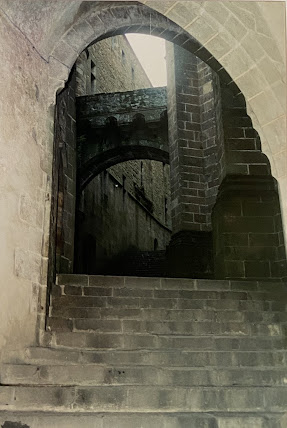












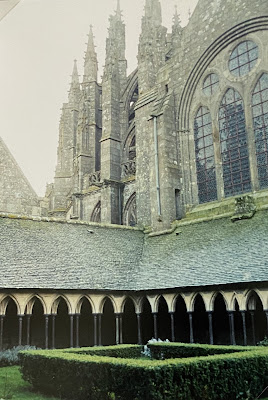
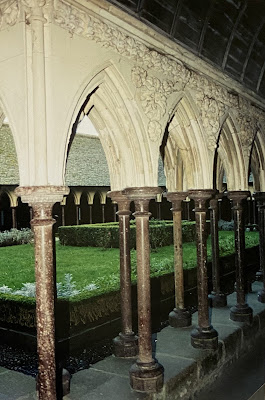






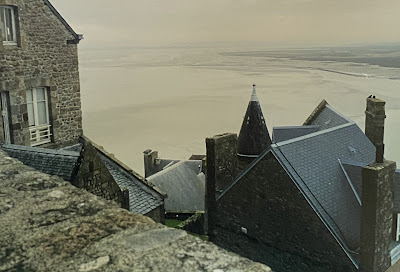







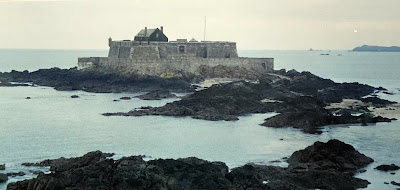



(Bob) This seems like a long time ago (23 years). Unbelievable to see the kids looking so young, particularly Andrew. Loved Mont Saint Michel - glad we got to see it when it was not as crowded as it is today. Saint Malo does not hold the same memories, I remember looking in shops and looking at the city from the walls.
ReplyDelete